Creative workshop to design cyborg citizens
Workshop ‘ideation and creative concept development’
Cyborg citizens in the year 2028 will include nanobots and AI. Wait what the f*&#? Okay let’s take 1 step back…
It’s the year 2018 and we surround ourselves with technology. Instead of fighting against all this automation, students from the Fontys minor ‘Embrace Technology Entrepreneurship and Creativity’ are asked to design and develop something awesome over the course of 6 months. They are guided through a series of phases, each with their own purpose and output. During the ‘ideation’ phase students are challenged to brainstorm and think big about everything they could work on. Allardata was asked to quickstart their creative process in two 2-hour interactive workshops. Ofcourse we brought the ususal post-its, colored markers and large flipover sheets but never forget to bring a surprising funfactor…
Whát they designed was not the main focus for this workshop. Rather the creative process and experience a new way to collaborate that was key. Turns out brainstorming about futuristic tech-enhanced-humans brings out a lot of creativity!
What, who, where and why?
- What: Interactive design workshop
- When: Monday 5th November 2018
- Where: Fontys Pulsed minor ‘Embrace TEC‘.
- Who: Students participating in the minor
- Why: Facilitate students to generate and capture their ideas
Lesson one: write less, draw more
We all know how boring it can be to write long reports, right? Typing for the sake of delivering output. Why do we still do this so much? Why do so many schools ask that of their students? Who likes reading those? We are so drilled and schooled to write that at a later age we ‘un-learn’ much of our creativity. Opening a laptop for every assignment doesn’t help either! It is hard to collaborate and be productive in a meeting when 8 distracted people have their laptop open staring at some random emails or websites.
It was fun to see students taking on the challenge to make little drawings next to their text-written lists. Drawing a drone, a medical robot or an exoskeleton actually helps other to understand the actual end-product they were designing. Drawing makes ideas come to alive, makes it possible to convey a message in a universal language and at the same time it includes the creative half of your brain.
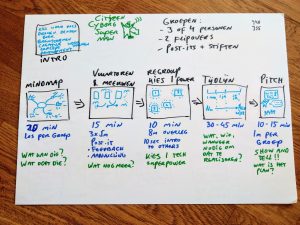 This sketch-up was our internal sessionplan, version 2. First version was a real mess and I decided not to make a cleaner digital version number 3 because I would only use it for myself. It’s added here to show how frames, illustrations and colors can make a document come alive. Yes, it’s ugly and the handwriting sucks, but it was finished in 30 minutes and worked perfectly for the purpose of designing the session. Sometimes fast and chaotic is perfect.
This sketch-up was our internal sessionplan, version 2. First version was a real mess and I decided not to make a cleaner digital version number 3 because I would only use it for myself. It’s added here to show how frames, illustrations and colors can make a document come alive. Yes, it’s ugly and the handwriting sucks, but it was finished in 30 minutes and worked perfectly for the purpose of designing the session. Sometimes fast and chaotic is perfect.
From nothing to something in 90 minutes
This workshop was split into 5 separate parts, each functioning in their own way contributing to the overall creation process. Students received the challenge to design a high-tech citizen superhero that is not born or giften with powers but has to be developed. Start imagining the endresult before thinking on how to get there.
Step 1: create a mindmap
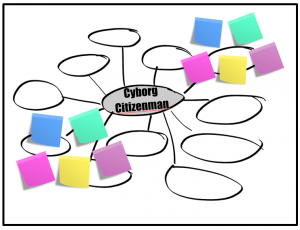
Mindmapping is great for collecting different thoughts and ideas into 1 overview. Extra benefit compared to most other workforms is that multiple team members can work simoultaneously,
because everyone that has a marker can think about more stuff on their ‘side’ of the mindmap tree.
Step 2: peer-feedback
After spending 20 minutes with a group of 3-4 people, the attendees where asked to leave their mindmap on the table and visit other groups. Armed with colorful post-its they provide more input, extend the already wild ideas with even more crazy superpowers and applications. Clue this round is that 5 minutes is more than enough to give/receive valuable feedback on any idea. Tip for everyone: ask for eachothers input more often, to expand and test ideas in the early stages.
Step 3: regroup and focus
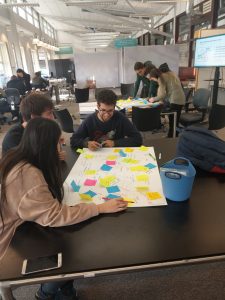 All groups were curious for the post-its with remarks, ideas and questions they got from other students. After imagining magic and having laughs about crazy stuff, it’s time to separate one concept from all the noise.
All groups were curious for the post-its with remarks, ideas and questions they got from other students. After imagining magic and having laughs about crazy stuff, it’s time to separate one concept from all the noise.
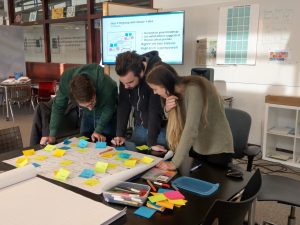
You needed those ‘bad ideas’ in order to find the good ones, but we leave those behind now. All groups received post-it-note input and have to determine which of the technology drive supercitizen powers they want to use as input for next step.
Here is a handfull of the marvelous ‘cyborg citizen powers’ they came up with:
- Fire-resitant bodysuit
- Extended vision to look through walls
- Mind-controlled drone swarm
- Nanobots for self-healing
- Sight-detection-analysis to recognize people’s medical needs
- Ironman-like foldable exoskeleton suit
- Interchangable bionic body parts with special tools (like a ‘spork’)
- Bullet-recycle mechanism to use gunfire for new construction
Yes, creativity florished!
Step 4: what do you need? (timeline)
Sometimes it’s easy to determine next steps. Especially when you have a short timeframe and a very predictable end goal in mind. But if you dreamt up AI-controlled drones or nanobots there is a benefit of setting your mindset to short-, medium- and long-term.
Multiple groups had the idea of onboarding Elon Musk, NASA and other establised institutions or influential figures. If you want them to be involved 1 year from now, what can you do next month to get that ball rolling? And if you want a working consumer product in 5 years, how will your prototype v2.0 look in 1 year? Who should you include to visualize prototype v1.0 next month to attract investors?

Step 5: elevator-pitch (60 seconds)
What if a random billionair joins you in the same elevator, asking you for advice on how to spend his time and money… What would you tell him you are working on? Always be prepared to give a summary of the endresult you have in mind and next steps on getting there. That’s what an elevator pitch is about.
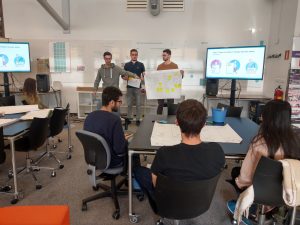
Students had 30-45 minutes to determine steps and describe necessary things for short, medium and longterm in order to realize their high-tech-citizen. Now was their moment to shine and enlight the others about what they came up with. We enjoyed a variaty of plans, sketches, productnames, drawings and pitches but all of them where entertaining and creative.
Conclusion and follow-up
Good to see so how a grumpy and passive Monday morning quickly turned into a discussion about drone-sizes and nanobot safety. We are proud to facilitate such an energetic process! But mostly it is valuable to see students leaving their laptop in their bags and use colorful markers to draw cyborg icons as a step towards more creative concept creation and high-energy co-creation.
Let’s just hope Elon Musk will indeed step into the same elevator so I can tell him about funding a interchangable spork-arm and AI drone swarms!
More info about this Minor?
This minor is part of Pulsed (http://pulsed-edu.com/). Check out the Pulsed ‘Embrace TEC’ website for more info and registration for the ‘experience day’ for potential students on thursday November 15th 2018 from 15:00 to 18:00. Are you, or do you know, a student in Eindhoven that has to choose a minor, please let them know!
Do you feel stuck in word documents and curious to how a more creative workform could spark new energy and fun? Please contact Allardata for help!
